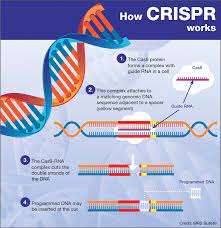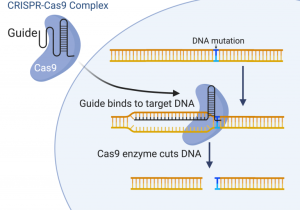CRISPR-Cas9: The Most Effective Method of Gene Editing
Written by: Aditya Hansoty
Gene editing is a form of genetic engineering in which DNA can be inserted into or deleted from the genome of a living organism. In 2012, George Church, Jennifer Doudna, Emmanuelle Charpentier, and Feng Zhang, were successful in complexing the CRISPR-Cas9 complex with a guide RNA (gRNA) in order to perform nucleotide analyses that enable site-specific gene modification. This powerful technology, known as CRISPR-Cas9, is the most effective method of gene editing.
What is CRISPR-Cas9?
Gene editing is performed using enzymes that have been engineered to target a specific DNA sequence. They cut into these DNA strands, remove existing DNA and insert replacement DNA. Technology such as this can be used to remove disease-causing genes and stop mutations from occurring, in both humans and animals. CRISPR stands for Clustered Regularly Interspaced Short Palindromic Repeats, which is the basis for CRISPR-Cas9 genome editing technology. In simpler terms, CRISPR-Cas9 uses two key genetic materials, the first being an enzyme known as Cas9. Cas9 acts as a pair of molecular scissors which can cut DNA. The second molecule is a strand of RNA, which, in simpler terms, guides the Cas9 enzyme, based on gene sequences selected by scientists, to the exact location of the cut in the DNA. This process is detailed in Figure 1. In addition to the two key genetic materials, the CRISPR-Cas9 complex also performs nucleotide analysis. This process enables site-specific gene modification by identifying the exact location of the cut in the DNA. The guide RNA (gRNA) in the CRISPR-Cas9 complex is responsible for this process. The gRNA is designed to match the target DNA sequence, and once it binds to the DNA, it enables the Cas9 enzyme to perform nucleotide analysis with the 3′ to 5′ nucleotides of the gene that it binds to. This analysis allows the Cas9 enzyme to determine whether the DNA sequence is a match for the target sequence, and if it is, the enzyme will cut the DNA at that location. Compared to other methods of gene editing, the CRISPR-Cas9 method is “the simplest, most versatile and precise method of genetic manipulation and is therefore causing a buzz in the science world (yourgenome.org).”
Figure 1

Overview of CRISPR-Cas9 Method
Source: MRS – Cambridge Core
How is CRISPR-Cas9 effective?
CRISPR-Cas9 has a lot of potential to serve as a tool for many genetic conditions, such as cancer, hepatitis B, and even high cholesterol. Many researchers have proposed applications for editing the genomes of reproductive cells, but in recent years there has been much debate on the ethicality of editing these cells. Editing reproductive cells means the effect will be passed on through generations. Hence, if an improper alteration or repair were to occur, the trait could be passed down across generations of edited cell lines and mutate. Due to this, most genetic editing on reproductive cells is illegal. Despite most methods being unsafe, using CRISPR-Cas9 to edit reproductive cells is safe and it has already been used to treat life-threatening human diseases.
Figure 2

A visual of Cas9 cutting DNA
Source: UCL Institute of Ophthalmology
Applications of CRISPR-Cas9
CRISPR-Cas9 has a wide range of applications in various fields. Some of the most promising applications of CRISPR-Cas9 are agriculture, medicine, biotechnology, and environmental science. In agriculture, CRISPR-Cas9 can be used to create crops that are more resistant to pests and diseases, which can help to increase crop yields and reduce the use of harmful pesticides. In medicine, CRISPR-Cas9 can be used to treat a wide range of genetic diseases, including cancer, sickle cell anemia, and cystic fibrosis. In biotechnology, CRISPR-Cas9 can be used to create new biotech products, such as biofuels and bioplastics. Finally, in environmental science, CRISPR-Cas9 can be used to create organisms that can help to clean up pollution and reduce the impact of climate change.
Conclusion
Due to CRISPR-Cas9 being a fairly new technology, there have been a limited amount of trials on humans, but growing in frequency in recent years. However, with many scientists and researchers devoting time, effort and money in order to improve it, the sky’s the limit for CRISPR-Cas9 technology, which may one day be able to change our world for the better.
References and Sources
CRISPR: Implications for materials science. (n.d.). Cambridge Core. Retrieved September 24, 2022, from https://www.cambridge.org/core/journals/mrs-bulletin/news/crispr-implications-for-materials-science
What is CRISPR-Cas9? (n.d.). @Yourgenome · Science Website. Retrieved September 24, 2022, from https://www.yourgenome.org/facts/what-is-crispr-cas9/
Kennisgeving voor omleiding. (n.d.). Retrieved September 24, 2022, from https://www.google.com/url?sa=i&url=https%3A%2F%2Fwww.cambridge.org%2Fcore%2Fjournals%2Fmrs-bulletin%2Fnews%2Fcrispr-implications-for-materials-
CRISPR/Cas9. (2022, July 26). CRISPR. Retrieved September 24, 2022, from http://crisprtx.com/gene-editing/crispr-cas9
1 thoughts on “CRISPR-Cas9: The Most Effective Method of Gene Editing”